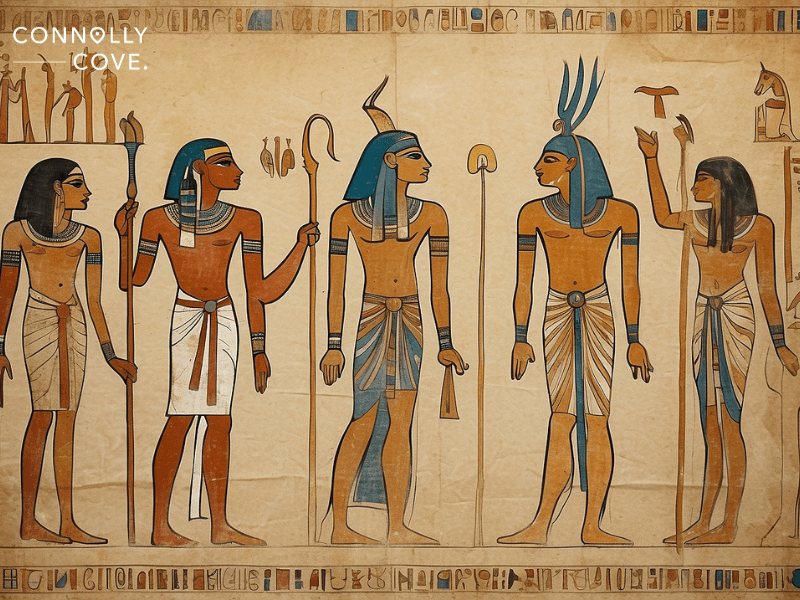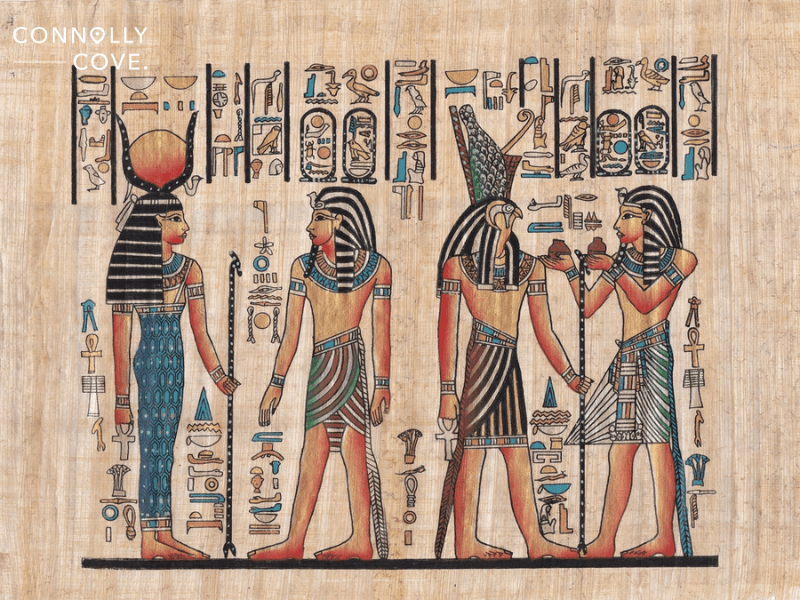Egyptian Afterlife: Revealing 10 Interesting Facts About Ancient Civilisation

Updated On: April 20, 2024 by Miranne Khaled
In diverse societies, death is typically seen as the ultimate endpoint, evoking a daunting fear among people. Nevertheless, there have been civilisations that, throughout history, have embraced a distinct viewpoint, firmly holding onto the belief in an afterlife.
In ancient Egyptian mythology, there existed a fascinating concept surrounding the afterlife. According to this belief, an individual’s journey did not end with the death of their physical body. Instead, it continued through the illustrious Hall of Judgment. One of the most captivating cultures in this regard is ancient Egypt, where they remained steadfast in their conviction that their ethereal essence would persist in an afterlife remarkably reminiscent of their earthly existence.
Nevertheless, it is crucial to acknowledge that the concept of an afterlife can significantly differ among various belief systems. The enchanting realm of the Egyptian afterlife should never be overlooked, as it holds a rich tapestry of unique ideologies worth exploring.
Securing a passage to this extraordinary realm was far from certain; the departed souls were compelled on a harrowing voyage through the hazardous underworld, where they faced a daunting final judgment before earning their rightful entry. Delving into the intricate details of the Egyptian afterlife and their profound perspectives on death unveils a captivating insight into the deep complexities entwined within the beliefs of this ancient civilisation.
The Concept of Journeying to the Egyptian Afterlife

In the mesmerising expedition through the intriguing depths of the underworld, the soul embarks on an extraordinary adventure, facing a myriad of gods, enigmatic creatures, and formidable gatekeepers – all relentless hindrances on their path towards encountering the revered Osiris and gaining entry into the illustrious hall of final judgment.
This defining moment, the pinnacle of the afterlife quest offers an unparalleled opportunity for the departed to ardently plead their case, hoping to secure access to the realms beyond. As the treacherous journey through the underworld draws to a close, the deceased finally reach the awe-inspiring hall of final judgment, where their ultimate destiny is waiting to be decided.
In the realm of their eternal journey, this pivotal turning point unfolds with a mesmerising blend of profound significance and uncertain possibilities. The power of this transcendental moment reverberates through a carefully crafted two-part process, guiding them towards the path of self-discovery and enlightenment.
Brace yourself for an enthralling exploration as we delve into the profound depths of this transformative experience. Find yourself captivated by the deep significance and lingering uncertainty that swirls around this monumental juncture, leaving an indelible mark on their everlasting odyssey.
Part 1: The 42 Divine Judges
In a truly awe-inspiring moment, they stood before a gathering of 42 celestial judges, and their hearts weighed down by the gravity of their entire existence. Yet, amidst the uncertainty, a glimmer of hope arose as they immersed themselves in the ancient and sacred tome known as the Book of the Dead.
Within its ancient pages lay the precise words to utter before each judge, words that possessed the incredible power to determine their fate. These hallowed utterances held within them the potential to pave a path through this crucial stage of judgment, granting even those who had not lived a perfectly virtuous life a chance at redemption.
Part 2: The Role of Ma’at and Her Feather of Truth
Here, every soul faced an extraordinary test, where their heart, the vessel of their true nature, was weighed against the feather of truth, guided by Ma’at, the goddess embodying cosmic balance, justice, and truth. Ma’at’s feather, known as the Feather of Truth, held great significance.
If the deceased person’s heart balanced harmoniously with Ma’at’s feather on the divine scales, they could continue their sacred voyage towards the afterlife. It was then that this feather demonstrated its transformative power, becoming a tangible symbol of truth and justice.
However, should an individual’s heart prove heavier than the Feather of Truth, a sinister fate awaited them. Their heart would be consumed by Ammut, the fearsome devourer, and their soul would be cast into the unfathomable darkness, forever severed from the enlightenment of the afterlife.
The Book of the Dead

The captivating origins of the Book of the Dead can be traced back to the remarkable New Kingdom, wherein it evolved from a rich legacy of enchanting funerary compositions. Among these, the illustrious Pyramid Texts held eminence reserved solely for the esteemed Egyptian royalty. This extraordinary masterpiece of ancient times can be described in contemporary terms as a compendium of ceremonial spells, intricate instructions, and mystical incantations.
By wielding this mystical guidebook, the deceased would seamlessly embark on a magnificent journey towards the afterlife, ultimately achieving divine unity with the radiant Sun God, Re, and the awe-inspiring Netherworld God, Osiris. The Book of the Dead unveils its mesmerising power within this sacred continuum of renewal and rebirth.
The Ka and Ba Concepts
The ancient Egyptians believed in a captivating and complex concept of the soul, which the Book of the Dead vividly illustrates. This sacred text not only provides a detailed portrayal of the afterlife and the divine roles of the gods, but it also acts as a gateway to the fascinating concepts of the ka and ba that go beyond mortal existence.
In Egyptian belief, the soul consisted of three distinct components: the ka, the ba, and the akh. While both the ka and ba were ethereal elements experienced by all individuals, the akh was a rare essence reserved for those worthy of embracing maat kheru. Even more intriguingly, the ba represented the very essence of an individual, serving as the core that defines their uniqueness.
Symbolised as a human-headed bird soaring beyond the realms of life, the ba reveals its eternal existence. On the contrary, the ka plays a vital role in sustaining an individual’s existence, acting as the life force that breathes vitality into their being. Through these enthralling and profound concepts, the Book of the Dead offers a mesmerising exploration into the enduring mysteries of the Egyptian soul.
The Spell that Saves Their Afterlife
In ancient Egypt, individuals were remarkably able to secure their success during a momentous trial. They turned to an age-old remedy, inscribing a powerful spell from the treasured Book of the Dead onto their heart scarab amulet. This spell was believed to protect them from any risk of their heart deviating from their virtuous intentions.
As the trial reached its critical stage, those fortunate enough to demonstrate a perfect balance between their deeds would be granted the honour of standing before Osiris, the revered deity of the afterlife. As the soul stood face-to-face with Osiris, there would be a warm welcome and guidance into the timeless realm beyond earthly existence.
This captivating myth not only sheds light on the profound beliefs of ancient Egyptians but also emphasises the importance they placed on truth, justice, and the moral journey every soul must undertake. It provides us with a fascinating glimpse into the intricate rituals and belief systems intricately woven into their culture, revealing the depth of their quest for righteousness.
The Mummification Process and Its Significance in Egyptian Afterlife
The ancient Egyptians held firm beliefs in the existence of an afterlife, which led to the development of a highly elaborate and sacred practice known as mummification. This intricate process was seen as crucial to ensure a smooth transition of the soul into the next realm. Beyond just mere physical preservation, it symbolised a profound spiritual significance.
Once the meticulous mummification was complete, the honoured bodies were laid to rest in burial tombs, carefully prepared for their journey into eternity. Why did they go to such lengths? The reason was twofold. Firstly, the Egyptians believed that the mummified body served as a sacred vessel, a home for the soul or spirit, and its preservation was vital to avoid the possibility of the spirit being lost.
Secondly, they firmly believed that the afterlife mirrored the present life, and therefore, they desired to bring along all their cherished possessions to ensure a prosperous and fulfilling existence in eternity. By entombing their material possessions, these ancient Egyptians sought to create a seamless continuation of the life they so revered.
The Great Pyramids and Their Connection to the Egyptian Afterlife
The towering pyramids are more than just a famous tourist destination that draws people from all over the world. These vast complexes that grace the Egyptian desert today serve as magnificent testaments to the ancient civilisations’ belief in the transcendence of life after death. Designed as majestic mausoleums, these awe-inspiring structures were erected to encapsulate the final resting places of the revered pharaohs.
In the eyes of the Egyptians, death was not an end but rather the commencement of an extraordinary journey to the hereafter. Intricately constructed with meticulous precision, the pyramids not only embodied the incomparable might of the pharaohs but also held immense religious significance.
Amongst all the pyramids, the renowned pyramids of Giza stand as a testament to the unwavering devotion and respect bestowed upon the pharaohs, honouring their legacy whilst serving as celestial abodes once their mortal journey came to an end. Considered demigods, it was believed that the pharaohs would seamlessly transition into the everlasting realm of the afterlife, carrying with them their divine essence from the mortal realm.
The Impact of the Egyptian Beliefs in Afterlife on Modern Society
Throughout history, the impact of ancient Egyptian civilisation is immeasurable, as it has played a significant role in shaping numerous aspects of our lives today. From groundbreaking advancements in writing and mathematics to the earliest use of cosmetics and fragrances, the Egyptians have left an indelible mark on the way we communicate, travel, dine, and dress.
Moreover, their profound belief in a tangible afterlife had profound implications, empowering them to meticulously prepare for their own demise and find solace during moments of grief. This conviction also gave birth to intricate funerary customs and texts that served as a guide on their journey to the afterworld.
Consequently, the ancient tradition in Egypt endures, with individuals continuously navigating life on Earth while keeping eternity in their sights. From ancient pagan practices to a deeply rooted Christian era, and finally, to the modern Muslim faith, the Egyptians have cultivated an unwavering awareness that death is but a stepping stone rather than a definitive end.
Whether or not you believe in the enigmatic allure of the Egyptian afterlife, one cannot deny the awe-inspiring sense of grandeur that permeates every step through this magnificent ancient civilisation.






